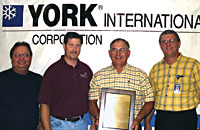
Let's put it this way: These are the only two schools in the state that are now nationally accredited through the Partnership for Air-Conditioning, Heating, Refrigeration Accreditation (PAHRA) program.
"PAHRA is proof that our students will receive the education they need to be successful in the industry," remarked HVAC instructor Roy Waldroop, from Moore-Norman Technology Center. "It guarantees to contractors that the students they hire from the Norman program will be prepared when they enter the job market."
Mike Henry, an HVAC instructor from Autry Technology Center, was just as pleased with his institution's recent accomplishment.
"The reason we decided to become accredited was our desire for students to be able to receive ICE [Industry Certification Exam] certification upon completion of our program," said Henry. "Since this is a national certification, it will carry more weight with future employers in other states than the state competency test."
In short, accreditation from PAHRA certifies that the HVACR programs at these institutions have exceeded industry standards in its instruction, curriculum, student, faculty, and facility standards set forth by the industry in residential air conditioning and heating, light commercial air conditioning and heating, and commercial refrigeration.
"This was not an easy feat," said Pat Murphy, president of PAHRA and vice president of certification for North American Technician Excellence (NATE). "The standards set by professionals from within our industry are very high. PAHRA raised the bar for HVACR programs to achieve excellence, and these schools have proven they are up to the challenge."

The Process
To become accredited, a training school must first evaluate its own strengths and weaknesses as compared to industry standards and then submit its findings in a self-study report. A survey team then conducts an on-site visit to confirm the self-study report."Students entering our programs need to be assured that the training we offer has been validated and approved by the industry," said Henry, who has been teaching at Autry for the past nine years. "Also, it is important that people outside of our programs understand our commitment to meeting industry standards and providing students with a quality education.
In return for our becoming PAHRA-accredited, Autry Technology Center receives equipment donations from manufacturers through ARI [Air-Conditioning and Refrigeration Institute]."
PAHRA is supported by ARI, the Air Conditioning Contractors of America (ACCA), the American Society of Heating, Refrigerating, and Air Conditioning Engineers (ASHRAE), the Council of Air-Conditioning and Refrigeration Educators (CARE), the Gas Appliance Manufacturers Association (GAMA), the Heating, Airconditioning, and Refrigeration Distributors International (HARDI), and the Plumbing-Heating-Cooling Contractors - National Association (PHCC).
"It took approximately eight months to get accredited," said Waldroop, who has been teaching HVACR for 21 years and was a contractor with his own business for 10 years. "But we wanted to prove that we meet or exceed industry standards when it comes to our program and how we teach HVACR."
Since its launch in January 2001, a total of 27 schools have received PAHRA accreditation.
"The process was reasonably simple for us because of our structure in Oklahoma," explained Henry, who was a student at Autry in 1968 and 1969, while in high school. "Our programs are evaluated every five years by our State Department of Career Tech. The PAHRA accreditation in many ways is similar to that evaluation, so most of the documentation and self evaluation process required by PAHRA is something we have in place and update constantly."
The first step to accreditation is applying. PAHRA does, in turn, provide the self-study booklet and a list of requirements for each level of accreditation. The instructor has to identify where the individual curriculum matches up with the program requirements in the PAHRA curriculum guide.
"All of the information required is sent to PAHRA for evaluation," explained Henry. "If more is needed, they will notify you what additional information is necessary. After that, it's a matter of scheduling the site visit and providing the documentation to the site team during the evaluation.
"It isn't totally easy to accomplish, but it is certainly a process that can be completed in a reasonable amount of time with a reasonable amount of effort."
Third-Party Verification
While it took Moore-Norman Technology Center nearly eight months to get accredited, Henry said it took Autry nearly 12 months "from start to finish.""I highly recommend PAHRA accreditation to any program," said Waldroop. "It allows us to have a third party verify that your program meets or exceeds industry standards. PAHRA is proof that our students will receive the education they need to be successful in the industry."
As a technology center, Moore-Norman teaches an array of technical and professional trades, plus offers health career courses. The HVACR program has an enrollment of approximately 20 students each semester. The school, which started in 1976, offers a self-paced program, designed to allow students to complete the program at various times of the year. The center's curriculum is based on 1,560 hours of work, which usually takes about three semesters to complete.
Autry Technology Center, located about 90 miles northwest of Oklahoma City, offers 29 programs in business education, health careers, and trade and industrial education. It also offers short-term adult programs.
Publication date: 10/03/2005

Report Abusive Comment